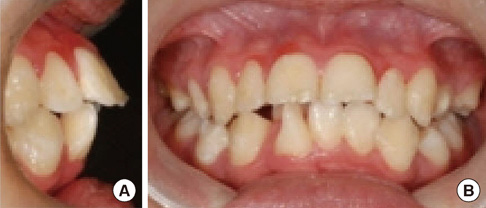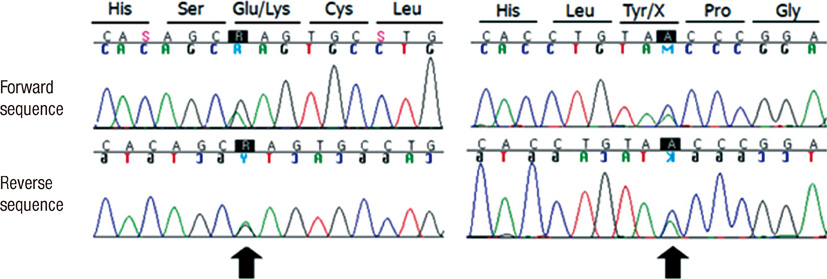J Korean Med Sci.
2012 May;27(5):565-568. 10.3346/jkms.2012.27.5.565.
Two Novel Insulin Receptor Gene Mutations in a Patient with Rabson-Mendenhall Syndrome: The First Korean Case Confirmed by Biochemical, and Molecular Evidence
- Affiliations
-
- 1Department of Pediatrics, Samsung Medical Center, Sungkyunkwan University School of Medicine, Seoul, Korea. jindk@skku.edu
- 2Department of Science Education, Ewha Womans University, Seoul, Korea.
- 3Department of Laboratory Medicine & Genetics, Samsung Medical Center, Sungkyunkwan University School of Medicine, Seoul, Korea.
- 4Department of Pediatric Dentistry, The Institute of Oral Health Science, Samsung Medical Center, Sungkyunkwan University School of Medicine, Seoul, Korea.
- KMID: 1372803
- DOI: http://doi.org/10.3346/jkms.2012.27.5.565
Abstract
- Rabson-Mendenhall syndrome (RMS) is a rare syndrome manifested by extreme insulin resistance with hyperinsulinemia, acanthosis nigricans, tooth dysplasia and growth retardation. Our patient was first noted at the age of 8 months due to pigmentations on skin-folded areas. Initial laboratory tests showed normal fasting glucose (69 mg/dL). Fasting insulin level was severely elevated, up to 554.6 microIU/mL, and c-peptide level was increased, up to 13.81 ng/mL. However, hemoglobin A1c was within normal range (4.8%). He is now 11 yr old. His growth development followed the 5-10th percentile and oral hypoglycemic agents are being administered. The last laboratory results showed insulin 364.1 microIU/mL, C-peptide 4.30 ng/mL, and hemoglobin A1c 7.6%. The boy was a compound heterozygote for the c.90C > A and c.712G > A mutations of the insulin receptor gene, INSR, which are nonsense and missense mutations. In summary, we report the first Korean case of RMS, which was confirmed by two novel mutations of the INSR.
MeSH Terms
-
Asian Continental Ancestry Group/*genetics
Base Sequence
Blood Glucose/analysis
C-Peptide/blood
Codon, Nonsense
Donohue Syndrome/drug therapy/*genetics
Heterozygote
Humans
Hypoglycemic Agents/therapeutic use
Infant
Insulin/blood
Male
Mutation, Missense
Receptor, Insulin/*genetics
Republic of Korea
Sequence Analysis, DNA
Figure
Reference
-
1. Ullrich A, Bell JR, Chen EY, Herrera R, Petruzzelli LM, Dull TJ, Gray A, Coussens L, Liao YC, Tsubokawa M, et al. Human insulin receptor and its relationship to the tyrosine kinase family of oncogenes. Nature. 1985. 313:756–761.2. Longo N, Wang Y, Smith SA, Langley SD, DiMeglio LA, Giannella-Neto D. Genotype-phenotype correlation in inherited severe insulin resistance. Hum Mol Genet. 2002. 11:1465–1475.3. Elsas LJ, Endo F, Strumlauf E, Elders J, Priest JH. Leprechaunism: an inherited defect in a high-affinity insulin receptor. Am J Hum Genet. 1985. 37:73–88.4. Longo N, Langley SD, Griffin LD, Elsas LJ. Two mutations in the insulin receptor gene of a patient with leprechaunism: application to prenatal diagnosis. J Clin Endocrinol Metab. 1995. 80:1496–1501.5. Longo N, Langley SD, Griffin LD, Elsas LJ 2nd. Reduced mRNA and a nonsense mutation in the insulin-receptor gene produce heritable severe insulin resistance. Am J Hum Genet. 1992. 50:998–1007.6. Park HS, Jin DK, Shin SM, Jang MK, Longo N, Park JW, Bae DS, Bae YS. Impaired generation of reactive oxygen species in leprechaunism through downregulation of Nox4. Diabetes. 2005. 54:3175–3181.7. Thiel CT, Knebel B, Knerr I, Sticht H, Müller-Wieland D, Zenker M, Reis A, Dörr HG, Rauch A. Two novel mutations in the insulin binding subunit of the insulin receptor gene without insulin binding impairment in a patient with Rabson-Mendenhall syndrome. Mol Genet Metab. 2008. 94:356–362.8. Longo N, Wang Y, Smith SA, Langley SD, DiMeglio LA, Giannella-Neto D. Genotype-phenotype correlation in inherited severe insulin resistance. Hum Mol Genet. 2002. 11:1465–1475.9. Musso C, Cochran E, Moran SA, Skarulis MC, Oral EA, Taylor S, Gorden P. Clinical course of genetic diseases of the insulin receptor (type A and Rabson-Mendenhall syndromes): a 30-year prospective. Medicine (Baltimore). 2004. 83:209–222.10. Longo N, Wang Y, Pasquali M. Progressive decline in insulin levels in Rabson-Mendenhall syndrome. J Clin Endocrinol Metab. 1999. 84:2623–2629.11. Desbois-Mouthon C, Magré J, Duprey J, Caron M, Blivet-Van Eggelpoel MJ, Daubas C, Gourmelen M, Chevallier B, Rizkalla S, Robert JJ, et al. Major circadian variations of glucose homeostasis in a patient with Rabson-Mendenhall syndrome and primary insulin resistance due to a mutation (Cys284-->Tyr) in the insulin receptor alpha-subunit. Pediatr Res. 1997. 42:72–77.12. Krook A, Kumar S, Laing I, Boulton AJ, Wass JA, O'Rahilly S. Molecular scanning of the insulin receptor gene in syndromes of insulin resistance. Diabetes. 1994. 43:357–368.13. Kadowaki T, Kadowaki H, Rechler MM, Serrano-Rios M, Roth J, Gorden P, Taylor SI. Five mutant alleles of the insulin receptor gene in patients with genetic forms of insulin resistance. J Clin Invest. 1990. 86:254–264.14. Tuthill A, Semple RK, Day R, Soos MA, Sweeney E, Seymour PJ, Didi M, O'Rahilly S. Functional characterization of a novel insulin receptor mutation contributing to Rabson-Mendenhall syndrome. Clin Endocrinol (Oxf). 2007. 66:21–26.15. Cheatham B, Kahn CR. Insulin action and the insulin signaling network. Endocr Rev. 1995. 16:117–142.16. Roach P, Zick Y, Formisano P, Accili D, Taylor SI, Gorden P. A novel human insulin receptor gene mutation uniquely inhibits insulin binding without impairing posttranslational processing. Diabetes. 1994. 43:1096–1102.17. Takata Y, Imamura T, Haruta T, Egawa K, Takada Y, Sawa T, Yang GH, Kobayashi M. Leu 193 mutation in the cysteine rich region of the insulin receptor inhibits the cleavage of the insulin receptor precursor but not insulin binding. Biochem Biophys Res Commun. 1994. 203:763–767.18. Kadowaki T, Kadowaki H, Accili D, Yazaki Y, Taylor SI. Substitution of arginine for histidine at position 209 in the alpha-subunit of the human insulin receptor. A mutation that impairs receptor dimerization and transport of receptors to the cell surface. J Biol Chem. 1991. 266:21224–21231.19. Maassen JA, Van der Vorm ER, Van der Zon GC, Klinkhamer MP, Krans HM, Möller W. A leucine to proline mutation at position 233 in the insulin receptor inhibits cleavage of the proreceptor and transport to the cell surface. Biochemistry. 1991. 30:10778–10783.20. Maassen JA, Tobias ES, Kayserilli H, Tukel T, Yuksel-Apak M, D'Haens E, Kleijer WJ, Féry F, van der Zon GC. Identification and functional assessment of novel and known insulin receptor mutations in five patients with syndromes of severe insulin resistance. J Clin Endocrinol Metab. 2003. 88:4251–4257.
- Full Text Links
- Actions
-
Cited
- CITED
-
- Close
- Share
- Similar articles
-
- A Case of HAIR - AN Syndrome
- A case of Pfeiffer syndrome with c833_834GC>TG (Cys278Leu) mutation in the FGFR2 gene
- A Case of Autoimmune Hypoglycemia Due to Insulin Receptor Antibody Associated with Empty Sella Syndrome
- A case of insulin autoimmune syndrome
- A Case of Hyperandrogenism, Insulin Resistance and Acanthosis Nigricans (HAIR-AN) Syndrome



